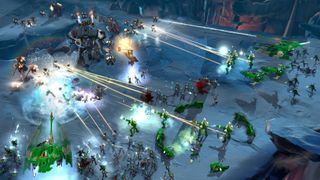Dawn of War 3: inside Relic's biggest RTS yet
Three races clash in the grim darkness of the 41st millennium.

Dawn of War 3 is real and we've seen it. For the full scoop check out the next issue of PC Gamer, which comes with a free Steam key for Dawn of War 2 and eight pages on the demo I saw at Relic headquarters recently.
For now, let's take a direct look at what's new in the sequel, which aims to merge the best aspects of Dawn of War 1 and 2 into Relic's biggest, most colourful RTS yet.
You play as three races in the campaign
Three races have been revealed: Space Marines, Orks and Eldar. The campaign moves between factions from mission to mission as each army converges on the same planet to retrieve a mysterious weapon. All of the factions have their own collection of heroes, elites, super units and super abilities that you develop over the course of the story. Gabriel Angelos returns to lead the Blood Ravens, and he'll tee off against an Eldar Farseer and an Ork Warlord.
Big armies are back
The battle I saw was comparable to a large-scale Dawn of War 1 encounter. Dozens of units exchanged glittering laser fire on an icy world. Hammer-wielding heroes and huge war machines waded through the troops, obliterating Eldar Guardians with rockets, gatling guns, bolters, flamers and brutal melee strikes.
There's method to the chaos. The designers want Dawn of War 3 to be their most accessible RTS yet, and that means making battles easier to read. Laser fire clearly shows where damage is being directed, and effects such as the Assault Marines' superhuman leaps are carefully calibrated to stand out in the busy battlefield. The result is a a visual hierarchy of threat that, Relic hopes, will make huge clashes easier to read.
In aid of this, some close detail has been sacrificed so Dawn of War 3 can shine in large-scale encounters, and Relic's artists have taken more inspiration from the colourful paint jobs of the tabletop game. It's a step away from the dark doom-laden tone of the fiction, and the game looks fantastic in motion.
Bases return
Dawn of War 1 style bases are back. They produce your workaday line units such as Tactical Marines, heavy-weapon Devastators and Dreadnought walkers. As in previous games, you build power generators and capture requisition points in the field to acquire resources.
Comic deals, prizes and latest news
Sign up to get the best content of the week, and great gaming deals, as picked by the editors.
If your Space Marines are too lazy to walk you can load units into three drop pods and smash them into a fight to surprise and squash the enemy. This is a key part of the Space Marines' 'death from above' strategy, which also incorporates jump-pack powered Assault Marines and a giant orbital laser—more on that later.

You collect and level up elite units
The designers talk about Dawn of War 3 armies in terms of line and elite units. Line units deliver continuous damage and try not to die; elite units deliver decisive strikes. Certain combinations of elite units will suit rush strategies, others will be more powerful lategame options. For example, returning Space Marine hero Gabriel Angelos is a close combat master that gives you a lot of power right away, so you might want to give another slot to a late-game ranged monster like the Imperial Knight.
You have three elite slots, which must be assigned before each battle. They are designed to let you define your play style, and to support a variety of strategies for each race. In the single player campaign you collect a wide range of elites that can be levelled up—an attempt to emulate the pleasure of collecting and building armies in the tabletop game. Elites can be individual heroes, crack units such as Assault Terminators, or super units.
For multiplayer, inspired by Dota's hero selection phase, Relic designers are considering an element of pick and counter-pick to the pre-battle screen, though they're yet to show exactly how this will work.
For Warhammer fans, units shown included Tactical Marines (with optional plasma weapon/flamethrower upgrades), Devastator Squads with lascannons, Dreadnoughts, Assault Marines, Gabriel Angelos, the Imperial Knight. On the Eldar side there were Guardians, Howling Banshees, Wraithguard, Falcons and Jetbikes. Unit upgrades give these line squads some tactical variation. Plasma weapons allow Tactical Marines to do more damage when stationary, but they they take the flamethrower instead they can lock down territory with fiery area-of-effect damage.
Super units are the series' biggest yet
Let's focus on the Imperial Knight for a moment. This huge walker is the biggest unit Relic has ever made. It has gatling cannons for arms and you can target missile bombardments from its back-mounted rocket launcher. Sometimes, when it gets very grumpy, it overheats and starts spewing fire out of its exhaust pipes. During this phase the gatling cannons glow white hot, the unit does more damage, and its bombardments create additional pools of burning flame on impact. It's ace.
Elite units like the Knight have special abilities, bringing some of Dawn of War 2's tactical micromanagement into Dawn of War 3. The knight has a sweeping gatling cannon attack that can deal massive damage to a forward arc, and the bombardment missiles can be individually placed, allowing you to scatter damage across the enemy line or focus in on one high-value target.

You can fire a giant orbital laser cannon
This is the Space Marine super ability. It calls a massive beam of death from the Dauntless battle cruiser orbiting the planet. Once the beam hits, you right-click to move it around. The more enemies it kills, the fatter, slower and deadlier it becomes, because that is how lasers work in Warhammer 40,000. Enemies caught in the laser are lifted upwards for a moment before they glow white hot and dissolve into ash.
A new cover system
Relic RTS games tend to have complex terrain with lots of medium and strong cover zones. The system has been simplified in Dawn of War 3 to allow for clearer counter-play. Cover in the demo I saw consisted of circular barricade structures that units can capture. Units in cover are resistant to ranged fire, but can be quickly eliminated by close-combat squads.
The change makes Dawn of War 3's big, chaotic battlefields easier to parse, and gives melee units an important role as siege-breakers. If you see an enemy heavy weapons team in cover, jump your Assault Marines in and watch them carve up the enemy squad with roaring chainswords.
That's all for now, but the speculation can begin. What will the Eldar and Ork super units be? What is the mysterious weapon on the planet? What do the Orks look like? Why not contemplate these issues while perusing our preview feature in the next issue of PC Gamer.
Part of the UK team, Tom was with PC Gamer at the very beginning of the website's launch—first as a news writer, and then as online editor until his departure in 2020. His specialties are strategy games, action RPGs, hack ‘n slash games, digital card games… basically anything that he can fit on a hard drive. His final boss form is Deckard Cain.
Most Popular



